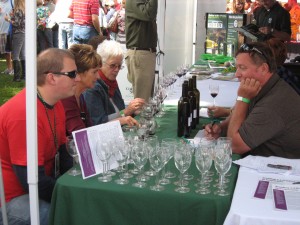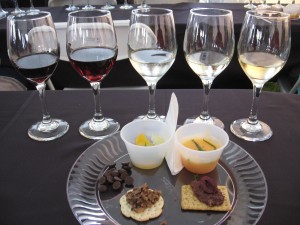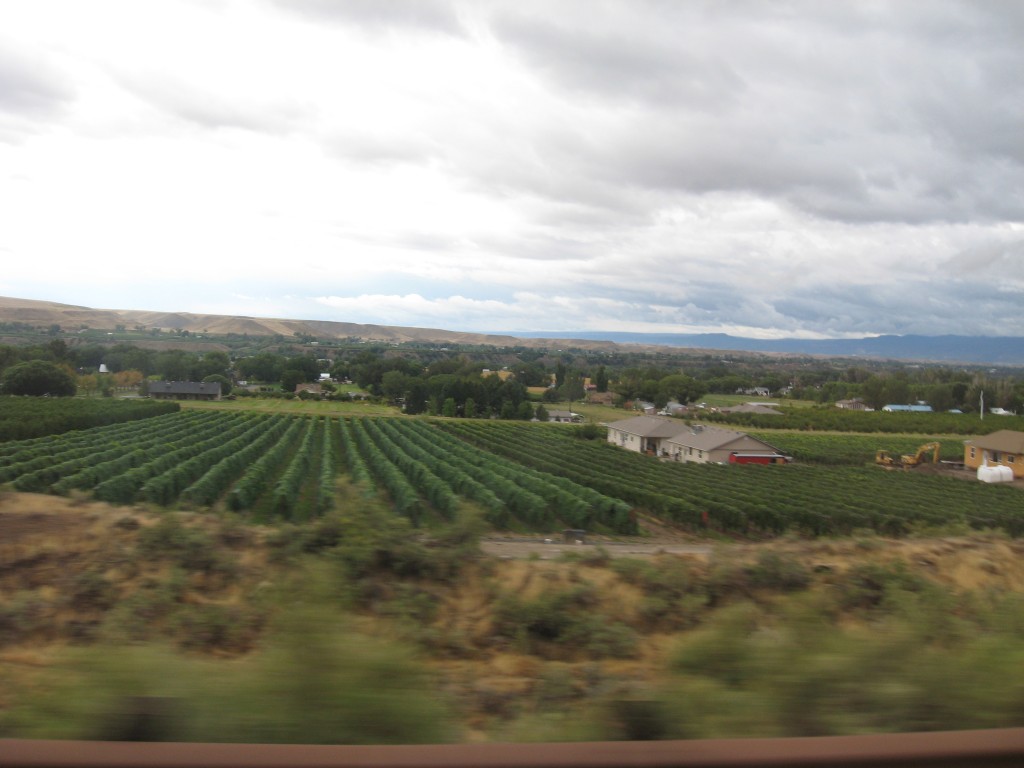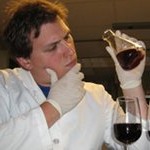
From the Denver/Boulder area, the Grand Valley AVA of Colorado is past the Continental Divide on the western slope of the Rocky Mountains. The trip westward on Interstate 70, which winds through canyons that the word “picturesque” struggles to describe, is rewarding if undertaken carefully to avoid notorious mountain traffic. After following the Colorado River through DeBeque Canyon, the scenery opens up into the Grand Valley, the heart of Colorado’s Wine Country, and the town of Palisade, home of the Colorado Mountain Winefest.
I recently moved to Boulder after spending six years in the wonderful wine culture that is the Finger Lakes region of New York. I was happy to find out that Colorado also had a burgeoning wine industry itself so when I learned about the Colorado Mountain Winefest, I had to be there.
No, a wine festival is not the best place to savor, ponder, and philosophize about individual wines. Often festivals are raucous affairs where the hoi polloi gather in droves to drink copious amounts of wine but buy none. However, a festival is a great place to taste a lot of wines in a short amount of time, so off I went.
Saturday in the Park
School buses made the rounds to hotels in nearby Grand Junction on the cool Saturday morning. For $13 round trip, no parking or driving to the festival was required. Things were starting off quite well as the day blossomed into the sunny mid-70s. It was a great day to be outside, made even better by spending it tasting wine.
Wine production on a commercial scale is fairly new to Colorado. In 1990, the state had just five wineries. By 2000 that number was up to forty and at present the state boasts roughly 100 wineries, around sixty of which came to pour at “Saturday in the Park,” the grand tasting of the festival. Wines poured included many Bordeaux and Rhône varietals in the red department, with whites represented by Muscat, Chardonnay, Riesling, and a smattering of Viognier. A handful of hybrid wines were also poured, including some made with cold-hardy Minnesota varieties like LaCrosse and Frontenac. Basically, a little bit of everything. Seminars were scheduled throughout the weekend, including presentations on food and wine pairing and the Riedel glass tasting seminar that is seemingly ubiquitous at these types of festivals.

The Saturday food and wine pairing seminar, given by Executive Chef Kevin Kidd and Beverage Director Evan Faber of SALT bistro in Boulder, was a highlight of the day and not only because it was a chance to sit in the shade far from the madding crowd. The duo’s earnest attempt to educate patrons on the black art of the perfect pairing really clicked with a combination of Plum Creek Riesling and a refreshing cantaloupe soup. These guys are foodies who get it. SALT is committed to using local ingredients and that ethos quite logically extends to wine.
First impressions of Colorado wine
So how did I find the wines? Many structured Bordeaux-style blends were noteworthy, though rich, fruit-forward Syrahs were often my favorites at given winery booths. I am not one for putting much stock in medals, but I suppose it is worth mentioning that of six double gold medal-winning wines at the “Best of the Fest” competition, there were three Syrahs, a Cabernet Franc, and a Malbec, the latter of which won best in show. I was a little underwhelmed by the white wine offerings, though a Riesling from the cooler, higher-altitude West Elks AVA (Black Bridge Marcellina Riesling) did make me a little homesick for the Finger Lakes. The West Elks AVA is is home to some of the highest commercial vineyards in the world, planted at altitudes of 5,700-7,000 feet. Rieslings from the warmer parts of the state reminded me more of Australia than of Germany.

It is possible, though, that the festival atmosphere was not exactly conducive to white wines’ success. Later in the festival I ran into a problem that happens at every wine festival I have been to. The white wines were too cold. Sitting in an ice-water bath for hours on end will rapidly bring the temperature under 40 degrees Fahrenheit, which (1) is cold enough to numb the teeth (especially if you are a frequent wine drinker with already sensitive teeth like yours truly), and (2) makes it nearly impossible to smell any aromatics. There is not much that can be done in the festival climate, though, as ice is about the only way to keep the wines cool. But just as it is beneficial to occasionally ice down reds on a hot, sunny day, it would really benefit the whites to have some time out of the ice bath. With this problem in mind, it is impossible to give a fair assessment of Colorado’s white wines from what I tasted.
A Developing Industry
I was surprised to learn that while the Grand Valley grows about 85% of Colorado’s grapes, almost half of Colorado’s wineries are located on the Front Range, that is, the other side of the Rockies. Grapes are harvested on the western slope, then trucked up (literally up, the highest point on I-70 is over 11,000 feet above sea level) to the eastern slope where they are vinified. According to several winemakers and owners I talked to, the reasons for shipping the grapes are two-fold. First, there are a lot more people (potential customers) on the Front Range. Second, land on the western slope is prime agricultural real estate, as evidenced by the peach and cherry orchards that seem to fill up any space not occupied by vineyards. Many wineries are located in cities like Boulder and Denver.

Colorado wine bears many of the hallmarks of a new industry. In such a rapidly growing environment, it makes sense that growers and winemakers are still figuring things out as they go. From my tastings at the festival, I did find some variation in wine quality. Some wineries are making excellent wines, while the occasional winery will make wines that are simply faulty. The industry, though, is taking steps to improve the overall quality of Colorado wines. A wine quality assurance study, in which trained evaluation panels test submitted wines for faults, is now underway, headed by state enologist Dr. Steven Menke. “We hope this will be the first step in the process of establishing robust quality assurance programs in Colorado and Nebraska,” said Dr. Menke in a recent press release, “and we hope to add chemical assessment and more quality assurance training for winery personnel in the future.”
Another interesting aspect of the Grand Valley (and something that might also contribute to variations in overall quality) is the heterogeneity of its mesoclimates. The climate is moderated by air that spills out of the canyon into the valley below, but the sloping terrain is prone to “frost pockets.” Even though the Grand Valley gets well over 3,000 growing degree days (GDD), a cumulative measure of seasonal temperatures (compare to 2,500-3,000 GDD on average in Napa Valley), vines can be prone to frost in the late fall and early spring. Winter kill is also a problem, with a deep freeze in 2009 taking temperatures to -10°F and killing many susceptible vinifera vines. Many early vineyards were planted based on a survey of the soil without taking into consideration these varying mesoclimates. “They planted the grapes and got a big shock,” says Dr. Menke.
From my tastings at the festival, standout wines included reds from Mesa Park Vineyards, unoaked Chardonnay and Syrah from Guy Drew Vineyards, Gewürztraminers and and interesting Lemberger from Carlson Vineyards, Riesling from Plum Creek Vineyards, and Bordeaux blends from Canyon Wind’s recently released Anemoi label. As the Colorado wine industry matures, quality variation will surely diminish. With the better producers already making very good wines, it seems that Colorado’s wine status will continue climbing higher and higher.
All photos courtesy Sarah Goonan.
Tom Mansell is the Science Editor here at Palate Press and a member of the Editorial Board. He has a PhD in chemical engineering from Cornell University, where he also learned to love the wines of the Finger Lakes. He is also the Science Editor for The New York Cork Report. Tom is currently living in Boulder, CO, where he is a researcher at the University of Colorado. Follow him on Twitter @mrmansell.

